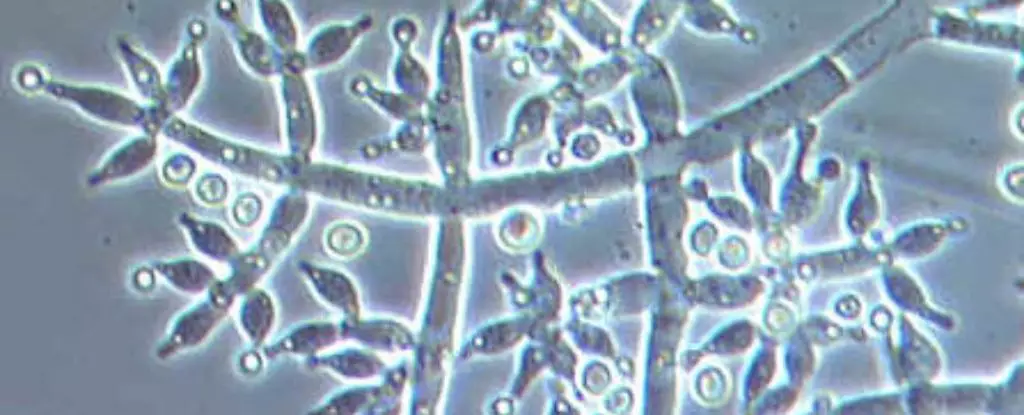The world of fungi is filled with mysteries that continue to captivate scientists. Among these peculiar organisms, Trichoderma harzianum stands out for its remarkable properties, especially in its relationship with plants. Recent research reveals a groundbreaking link between sound and the growth patterns of this ubiquitous fungus. In a surprising revelation, T. harzianum appears to thrive when exposed to specific sound frequencies. This discovery raises intriguing possibilities about harnessing sound as a tool to enhance soil health and agricultural productivity.
In an innovative study conducted by a team at Flinders University in Australia, scientists exposed T. harzianum to an intriguing soundscape: a high-frequency monotone crackle reminiscent of radio static. Over a series of meticulously designed experiments, they found that the fungus not only accelerated its growth rate but also significantly increased its spore production when subjected to this auditory stimulus. The experiments lasted for five days, during which the petri dishes of T. harzianum were carefully shielded from external noises. The results were striking; those exposed to sound dramatically outperformed those kept in silence.
This experimental setup underscores the effectiveness of sound as a variable in biological experiments. It also reflects a growing trend in scientific research, where the intersection of biology and physics yields unprecedented insights into organism behavior. With T. harzianum being a prevalent species in soils worldwide and known for its beneficial impact on plant health, this breakthrough could potentially revolutionize practices in agriculture and ecology.
The implications of this research extend well beyond the laboratory. T. harzianum is already appreciated for its role in enhancing plant growth by colonizing roots and combating pathogenic fungi that threaten crops. With the newfound understanding that sound can enhance its growth and spore production, farmers might one day utilize soundscapes as a method to bolster crop yields and promote healthier soils.
Jake Robinson, the lead researcher, points to the broader vision of utilizing sound to rejuvenate degraded lands and improve agricultural sustainability. Given the escalating global food demand and the pressing need for effective farming practices, incorporating such innovative methods could represent a major shift. If successful, eliciting enhanced growth in fungi using sound could also prompt a more holistic approach to ecosystem management, emphasizing the interconnectedness of various living components.
While the results are compelling, the mechanisms driving the enhanced growth remain shrouded in mystery. Researchers hypothesize that sound waves may activate specific receptors in the fungi, triggering a cascade of cellular responses. This reaction could either manifest as an electrical impulse or a biochemical signal, suggesting a complex interplay between environmental stimuli and fungal behavior. The potential for sound to influence gene expression or cellular activity opens a new frontier in microbial ecology, emphasizing the need for further exploration.
In the broader context, the research aligns with prior studies indicating the responsiveness of various organisms to sound. For instance, oyster mushroom cultivation has shown positive growth responses to specific sound treatments. However, this complexity must be navigated carefully, as sound can also have detrimental effects; previous research has revealed that certain noises, such as the hum of refrigerators, can exacerbate the growth of harmful fungi, presenting a dichotomy in potential applications.
Despite the promising findings, the journey of understanding sound’s impact on fungi is just beginning. Future investigations will need to clarify not only how sound influences T. harzianum but also whether such effects translate effectively in natural settings outside laboratory conditions. Moreover, it will be crucial to examine the potential consequences for plant interactions and overall soil ecosystems.
As scientists endeavor to unlock the secrets of how sound shapes our biological world, it opens up a myriad of questions about the communicative abilities of fungi, bacteria, and even plants. This research not only highlights the complexities of soil ecosystems but also invites us to reconsider our approaches to ecosystem management, restoration, and agricultural practices in an increasingly challenging environment.
The relationship between sound and the growth of Trichoderma harzianum provides a glimpse into the untapped potential of ecological restoration and agriculture. By treating soil with sound, we might stimulate beneficial fungal growth and improve agricultural practices in ways previously thought impossible. As research progresses, the fascination with fungi and their interactions with sound will surely continue to inspire innovative strategies for ecological improvement and sustainability, making waves in the scientific community and beyond.


Leave a Reply